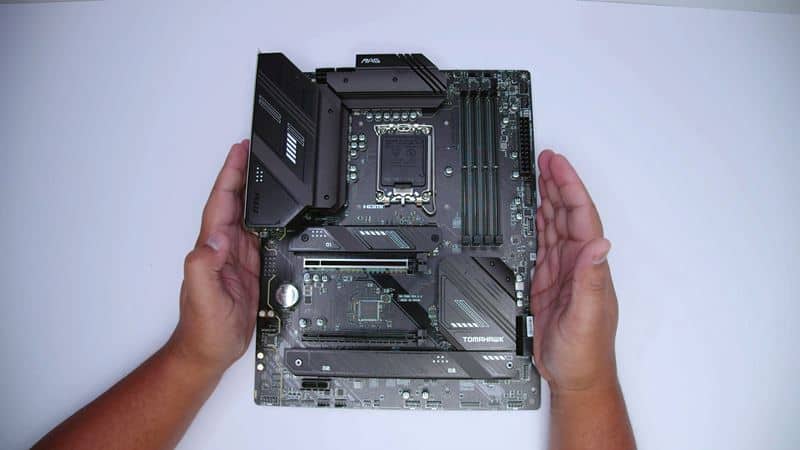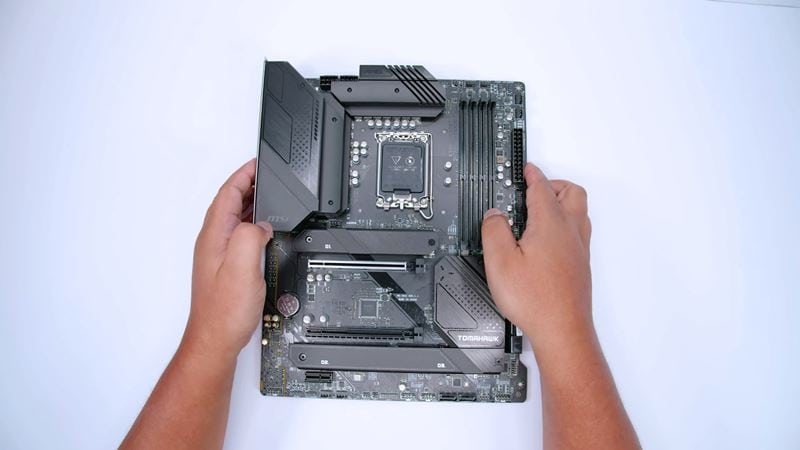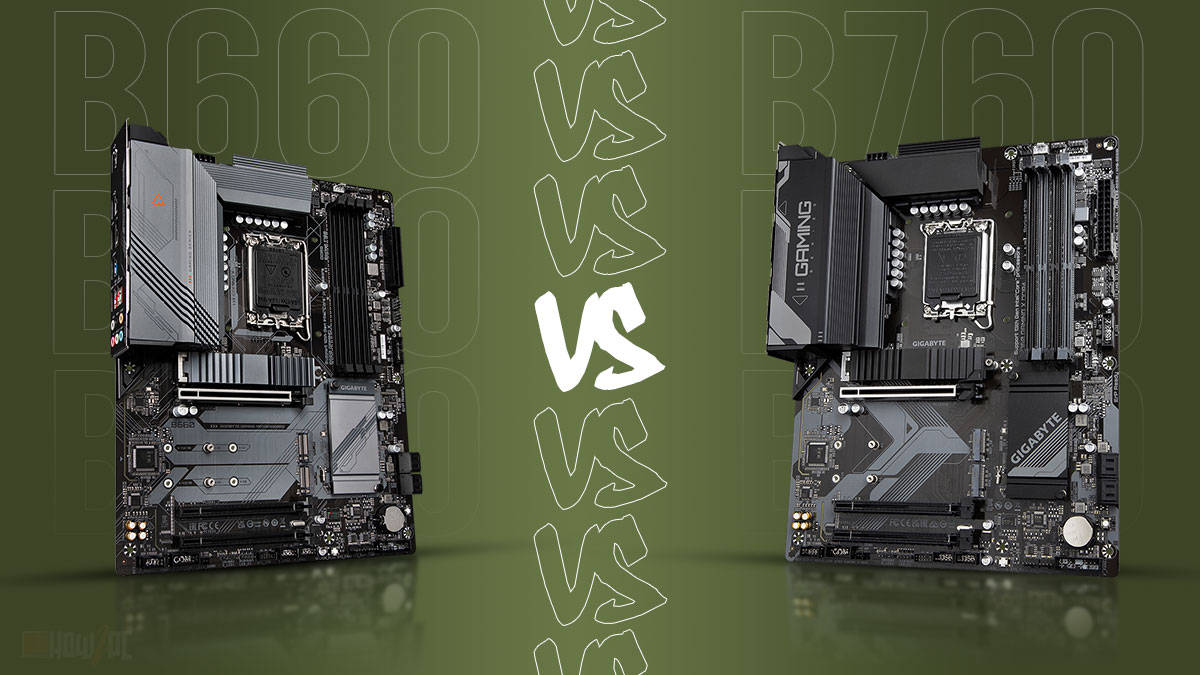Intel 14th-generation processors are out in full swing, and their initial reviews seem promising.
If you are looking to upgrade to the newly released Intel 14th generation processors or are looking to buy the discounted 12th or 13th generation Intel processors, you need the right motherboard.
In this article, I will compare two popular mid-range chipsets: B760 and B660. Both these chipsets support the Intel 12th, 13th, and 14th generation processors and use the same LGA 1700 socket, so which one should you choose?
Deciding between the B760 and B660 motherboard boils down to their differences in key aspects like CPU support, Memory, PCIe, Overclocking, USB Ports, and more, which I will discuss in this article. I will also highlight specific use cases of each of these motherboards.
Rest assured, at the end of the article, you will know all the key differentiating factors between the B760 and the B660. So, let’s dive right into the comparison.
Brief Overview of the B760 Motherboard Chipset

The B760 motherboard occupies the middle ground in Intel’s motherboard hierarchy. It comes with the LGA 1700 socket. This motherboard was released with Intel’s 13th-generation processors, and it has been going strong with Intel’s 14th-generation processors as well.
The B760 motherboard falls in the middle of the pack in Intel’s lineup. At the top is the Intel Z series chipset, and the rock bottom is the Intel H series chipset. Being in the middle of the pack, the B760 offers a good mix of features and performance at an affordable price.
In this comparison, I will stress whether the B760 has enough difference compared to the B660 or if Intel has just repacked the B660 motherboard chipset with a different name.
Brief Overview of the B660 Motherboard Chipset

The B660, like the B760, occupies the middle ground in Intel’s motherboard hierarchy. Since the B660 motherboard debuted with the previous 12th generation Intel processors, it is a generation older than the B760 motherboard. Like the B760, it also contains the LGA 1700 CPU socket.
Despite being a year older, the B660 motherboard is still going strong today. Therefore, in this comparison, I want to find out whether the B660 motherboard still has what it takes to run the latest PC hardware. Of course, to find this out, I will be comparing the specs and the features of the B660 to the B760. If the B660 motherboard has the same specs and features, then buying the B760 motherboard may be redundant.
Key Differences and Comparison
The comparison of B760 and B660 will focus on key aspects like CPU support, PCIe, Overclocking, Memory support, USB ports, VRM, etc. I will highlight all the key differences between these two motherboards in these key areas so you can make a more informed buying decision.
1. Specs Overview
| Chipset | B760 | B660 |
|---|---|---|
| CPU Support | Intel 12th, 13th, and 14th generation processors | Intel 12th, 13th, and 14th generation processors |
| Memory Support | DDR4, DDR5 | DDR4, DDR5 |
| Maximum Memory Support | 128GB | 128GB |
| Dual GPU Support | No | No |
| CPU Overclocking | No | No |
| Memory Overclocking | Yes | Yes |
| DMI Lanes | x4 | x4 |
| Chipset PCIe Revisions | PCIe 4.0, 3.0 | PCIe 4.0, 3.0 |
| Usable PCIe 4.0 Lanes | x10 PCIe Gen 4.0 | x8 PCIe Gen 4.0 |
| Usable PCIe 3.0 Lanes | x4 PCIe Gen 3.0 | x6 PCIe Gen 3.0 |
| Total Chipset PCIe Lanes | x14 | x14 |
| CPU PCIe Lanes Revision | PCIe 5.0 | PCIe 5.0 |
| Useable PCIe 5.0 CPU Lanes | x16 | x16 |
| CPU PCIe Lanes Configuration | 1×16 | 1×16 |
| Total CPU PCIe Lanes | x16 | x16 |
| SATA III (6Gbps) | 4 | 4 |
| USB Revisions | USB 3.0, USB 2.0 | USB 3.0, USB 2.0 |
| USB 20 Gbps Ports (USB 3.2 Gen 2×2) | 2 | 2 |
| USB 10 Gbps Ports (USB 3.2 Gen 2×1) | 4 | 4 |
| USB 5 Gbps Ports (USB 3.2 Gen 1×1) | 6 | 6 |
| No. of Supported Displays | 4 | 4 |
| Wi-Fi | Wi-Fi 6 | Wi-Fi 6 |
| Ethernet LAN | 2.5G or lower | 2.5G or lower |
| TDP | 6W | 6W |
As you can see from the specs table, the B760 and the B660 are quite similar. They seem identical if not for the difference in PCIe. However, as I always say, specs only tell half the picture.
Even though these two motherboards may appear similar, there is more than meets the eye, and for that, we will need to dive into more detail on both of these motherboards.
2. CPU Support
One of the most critical aspects of a motherboard is its ability to support multiple generations of CPUs. As a consumer, the last thing you want is to upgrade the motherboard every so often because the new hardware is not compatible with the motherboard.
In terms of CPU support, both the B760 and the B660 stand on equal footing. Since they are based on the LGA 1700 socket, they support Intel 12th, 13th, and 14th generation processors.
While both motherboards support Intel’s latest 12th, 13th, and 14th generation processors, they are not ready for it out-of-the-box.
The B660 motherboard only supports Intel 12th-generation processors out of the box. To get support for 13th and 14th-generation processors, you will need to upgrade the motherboard BIOS to the latest version.
Similarly, the B760 supports 12th and 13th-generation Intel processors out of the box but does not support the newly released Intel 14th-generation processor. To get support for the 14th-generation processors on a B760, you will need to upgrade its BIOS to the latest version.
If you desire the flexibility to use Intel’s 12th, 13th, and 14th-generation processors, the B660 is a viable option with the potential for a BIOS update.
However, if you are certain that you will be using a 13th or 14th Gen CPU, the B760 chipset is purpose-built for this generation and ensures seamless compatibility. Consider your long-term processor plans and compatibility needs when making your decision.
3. Memory Support
The new generation of Intel CPUs greatly rely on memory for their optimal performance. Memory technology has come a long way. Currently, the DDR5 is the latest standard for memory.
Although the DDR5 memory is great, like every new technology, it has issues. The DDR5 memory suffers from latency issues, and it is also very costly. Therefore, Intel has decided to keep DDR4 and DDR5 support in the B760 and the B660 motherboards.
This is a positive step because it allows consumers to choose whatever RAM they desire. It will also allow users on older platforms to upgrade to the B760 or the B660 without worrying about changing RAM.
However, it should be noted that DDR5 RAM provides better performance compared to DDR4 RAM. So, if you want to squeeze every ounce of performance, you should opt for DDR5 RAM.
4. VRM
The Voltage Regulator Module (VRM) is a component of the motherboard that is tasked with controlling and regulating the voltage that is supplied to the PC parts connected to the motherboard.
The responsibility of the VRM is immense because if the voltage is unstable, the PC will constantly keep on crashing and displaying issues such as the blue screen of death. Major deviations in voltage can cause catastrophic damage to fragile PC parts such as the CPU.
The VRM of the motherboard is also responsible for its overclocking capability. However, since neither of these motherboards offers overclocking support, the responsibility of the VRM in the B760 and the B660 is limited to keeping the voltage stable.
The B760 and the B660 both have identical VRMs. This pattern is clearly depicted if we take the example of two real-life motherboards: the Gigabyte B760 Aorus Master and the Gigabyte B660 Aorus Master.
The Gigabyte B760 Aorus Master has an 18-phase VRM with 60A power phases. Similarly, the Gigabyte B660 Aorus Master has an identical 18-phase VRM with 60A power phases.
Long story short, both of these motherboards have identical VRM, and one is not better than the other. So, they will both do a similar job of maintaining voltage and stability in a PC. Hence, you shouldn’t let the VRM influence your decision-making.
5. Overclocking
Overclocking means enhancing the performance of the PC hardware, like the CPU and memory, by increasing their clock speed. Overclocking is of two types: CPU overclocking and memory overclocking.
Unlike AMD, Intel only supports CPU overclocking on the Z series motherboards. So, neither the B760 nor the B660 motherboards support CPU overclocking. Therefore, you shouldn’t use K series Intel processors with either of these motherbroards.
Thankfully, Intel has not restricted memory overclocking on their mid-range motherboard chipset. So, both the B760 and the B660 support memory overclocking.
Their memory overclocking capability is also identical. They both contain XMP 3.0, which is Intel’s latest standard of memory overclocking. Therefore, you can achieve the same memory speeds on both motherboards.
All things considered, there is not much difference between the B760 and B660 regarding overclocking, and both motherboards show similar performance.
6. PCIe
If you examine the underpinnings of a motherboard, the PCIe is what holds the motherboard together. PCIe are pathways that link all the different components of the motherboard to one another and carry data from one place to another.
The efficiency of the motherboard is determined by how fast data exchange happens.. If the data is exchanged at a faster rate, the motherboard will be much more efficient. PCIe 5.0 can carry the most amount of data, followed by PCIe 4.0, 3.0, 2.0, and 1.0, respectively.
In terms of PCIe, the B760 and the B660 are vastly different. The B760 comes with more PCIe 4.0, as opposed to the PCIe 3.0 on the B660.
On the B760, the secondary PCIe x16 graphic card slot uses PCIe 4.0, while the same slot on the B660 uses PCIe 3.0, making the B760 motherboard superior in terms of PCIe expansion.
The PCIe 4.0 secondary graphics card slot on the B760 is quite beneficial for dual GPU configuration. PCIe 4.0 means the secondary graphic card slot gets adequate bandwidth.
Meanwhile, on the B660, the secondary graphic card slot, which uses PCIe 3.0, will not get adequate bandwidth in a dual GPU setup.
Having PCIe 4.0 is not only beneficial for just the graphic card, but it also gives greater flexibility in terms of expansion slots.
Therefore, in the PCIe department, the B760 takes the cake. It is the superior motherboard out of the two and offers greater flexibility and better dual GPU support due to having PCIe 4.0 on the secondary X16 graphic card slot rather than PCIe 3.0 like the B660.
7. USB Ports
The prominence of USB ports has greatly risen with a shift toward portability. These days, there are many useful portable devices, such as external hard drives.
These external hard drives require high-speed USB ports to reach optimal read and write speeds. So, it is highly important for a motherboard to contain enough high USB ports that it can support whatever external device you would like to throw at it.
In terms of the USB ports, the B760 and the B660 motherboards are identical. They both contain 2x USB 3.2 Gen 2×2 (20 Gbps) ports, 4x USB 3.2 Gen 2×1 (10 Gbps) ports, and 6x USB 3.2 Gen 1×1 (5 Gbps) ports.
You might be wondering what this entails for your user experience. Well, I can say with great conviction that both of these motherboards have more high-speed USB ports than you will ever need.
Every external device you throw at this motherboard, like external hard drives, DAC/Amps, Wi-Fi cards, and other peripherals, will work on this motherboard like a charm.
8. Future Proofing
What’s the worst that could happen? Well, let me tell you; the worst that could happen is having to upgrade or replace your motherboard because it does not support the latest PC hardware.
Knowing that your motherboard is future-proof and can last a long time before needing an upgrade puts your mind at ease. Future-proofing is of two types:
- Future-proofing based on CPU support
- Future-proofing based on the capability of the motherboard; this includes many factors like PCIe lanes, VRM, etc.
Unfortunately, in terms of future-proofing based on CPU support, neither the B760 nor the B660 are any good.
The 14th generation is the last generation of Intel before a socket change. This means that the newer 15th-generation Intel processors will come with a different socket, and that means the B760 and the B660 will be phased out for newer motherboards.
Another important aspect when it comes to Future-proofing is having ample PCIe expansion. In this regard, the B760 fares better than the B660.
The B760 comes with a PCIe 4.0 secondary x16 GPU slot, which gives the motherboard better dual GPU support and greater flexibility in terms of PCIe expansion. Meanwhile, the secondary X16 graphic card slot on the B660 uses PCIe 3.0, greatly limiting its connectivity.
The PCIe 4.0 on the B760 will prove to be better for future-proofing because the latest graphic card requires at least PCIe 4.0.
9. Cost
Ultimately, for most people, the cost is the main deciding factor. Let’s be honest: motherboards are expensive, and given the inflation-ridden economy these days, most people don’t have excess money burning a hole in their pocket.
When comparing the B760 and the B660 based on cost, the B760 is more expensive than the B660. However, the price difference is not what you think.
On average, the B760 is $10-35 more expensive than a B660 motherboard. To put it into perspective, we can use the example of Asus Prime B760 Plus and the Asus Prime B660M-A.
The MSI MAG B760 Tomahawk Wi-Fi costs $220, while the MSI MAG B660 Tomahawk Wi-Fi costs $190. So, based on the pricing of these two motherboards at the time of writing, you are saving $30 by buying a B660 instead of a B760.
Of course, the price gap will widen with a high-end B760 motherboard. However, the reason we are not considering a high-end B760 is because it will lead to an unfair comparison as there are not many high-end B660 motherboards to compare with.
All things considered, the $10-35 price difference is not too much. Even if you are on a very tight budget, I reckon you can skimp a few outings with your friends and save money for the B760. You will not regret it because the B760 is a better and newer motherboard than the B660.
Who Should Buy the B660 Motherboard?
Based on the specs and features of the B660, this motherboard should be your choice if,
- You are on a strict budget and are getting a great deal on a B660.
- You want a temporary motherboard that can last 1-2 years before eventually upgrading to Intel’s 15th-generation processor.
Who Should buy the B760 Motherboard?
Based on the specs and features of the B760, this motherboard should be your choice if,
- You want a motherboard with better dual GPU support and PCIe 4.0 expansion
- You want a motherboard with a better feature set
- You want a plug-and-play motherboard that does require BIOS update and supports Intel 12th and 13th generation processors out of the box.
Both the B760 and the B660 have their merits and demerits, but if you ask me, I would buy neither the B760 nor the B660. In a similar price bracket, you can get the Z690 motherboard, which is based on a more premium Z series chipset, offers better features, and is more capable than either the B760 or the B660. So, my choice will be the Z690. I have done a detailed breakdown and comparison of the Z690 and Z790 chipset. To learn more, you can read my article on Z790 vs Z690.
Related Guides
Check out some of the other motherboard comparisons.
Check out some of our related motherboard buying guides.



The Author Who Worked On This Article
Waleed Madni
A tech enthusiast with the spirit of a competitive gamer. Waleed has been around computers ever since he was young and has witnessed the progress of the machines he loves the most. Fascinated by what tomorrow has to offer, he keeps himself up to date with the latest technology and gaming trends.